Solar Gain
Harnessing the power of the sun used to be the hobby of choice for Bond villains – now it is proving a clean way of obtaining renewable energy.
Concentrating Solar Power (CSP) and solar thermal power towers have been a proven technology for many years, but until now no one has been able to make a cost-effective, utility-scale plant. The team from eSolar has worked hard to change this.
The eSolar Sierra SunTower power plant in Southern California uses small, flat mirrors that track the sun with high precision and reflect its heat to a tower-mounted receiver, which boils water to create steam. The resulting steam powers a traditional turbine and generator to produce electricity.

The eSolar Sierra SunTower
power plant in Southern California
Rick Ianello, VP of manufacturing at eSolar, reveals the secret to be smaller is better, “We use hundreds of thousands of small mirror assemblies to focus the sun’s energy onto our receiver. Because of the large number of assemblies we are able to take advantage of the economies-of-scale to drive down the material costs. The assemblies are prefabricated at the factory to increase quality and consistency while minimising assembly time in the field.
“The key that makes all of this work is our tracking software, which can accurately and precisely focus all of the mirror assemblies to maximise the energy to the receiver.”
Because of the demanding environment the equipment must survive in, and because of the precision it must maintain for 30 years, eSolar ran FEA and fatigue tests on almost every part. “We ran countless simulations on concept designs before we cut the first metal,” says Rick. “We did this to minimise the risks, speed time to market and reduce prototype expenses.”
SolidWorks was used for the mechanical design of the parts, with the team testing parts in a variety of software including Ansys Mechanical and CFX for FEA and fluid flow analysis. Complex issues like thermal simulation and the plant operation were completed using Flow Master and Thermal Flex to optimise the electricity generated.
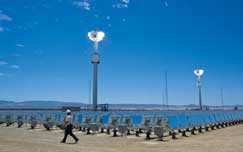
The eSolar plant features hundreds of thousands of mirrors which track the sun with high precision
Rapid prototyping played a key role early on in development as the team built test parts in a Fused Deposition Modelling (FDM) machine to validate parts or to help visualise the assembly processes in the factory. The first prototype was put through wind tunnel testing.
“The schedule was extremely challenging making long hours and countless trips to our suppliers necessary,” says Rick. “But the most difficult element was our extremely aggressive cost targets We knew we needed to find ways to reduce the amount of steel we used, the time to install the product in the field and the time to commission a plant in order to make this a truly competitive technology anywhere in the world.”
The finished plant is an incredible design; the pre-fabricated mirror frames fit easily into standard shipping containers for delivery to the site; it can be installed using basic hand tools; the turbine is a standard model, and the tower is a standard 150 foot tall wind tower component. Deployment is fast, efficient, and requires a minimum of surveying, training and heavy machinery, making it a universal means of generating clean energy.
Fuel for thought
Bio fuel is a growing alternative fuel choice. Commonly used to power vehicles and heat homes, it substitutes the use of rapidly depleting fossil fuels with newly ‘grown’ plant-based renewable energy.
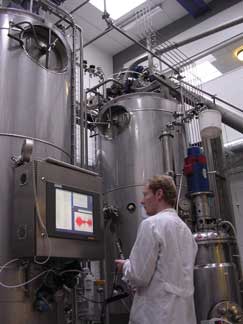
Producing bioethanol requires an efficient pre-treatment and fermentation system
Danish firm BioGasol, a spin-out of research being done at the Technical University of Denmark, develops and designs process technologies for the production of second-generation bioethanol, sometimes called cellulosic ethanol. Based on a new technology, it is being developed to derive sugars out of plant-based biowaste, rather than from food crops, and ferment these sugars into ethanol.
To produce bioethanol, BioGasol needed to design an efficient pre-treatment and fermentation system for processing the raw material that would eventually become the final product.
The team, based in Ballerup, designed the various components of the processing plant using Pro/Engineer, giving them the option to be able to scale the plant from a small demonstration model to a full-size production version, fully able to process more than 24,000 pounds of raw material – or biomass – per hour.
This second-generation bioethanol costs less to produce than conventional bioethanol and does not rely on food crops as an energy source, and produces even less greenhouse gas than first-generation bioethanol.
BioGasol began using Pro/Engineer as a design tool for building the C5 [sugars used to create bioethanol] fermentation systems. Engineering manager Rune Skovgaard-Petersen, explains the evolution of the design workflow, “We began by having brainstorming sessions and doing the rough sketches, then we used Pro/Engineer to draft up ideas and see how it works and how it all fits together.”
Buoyant with possibilities
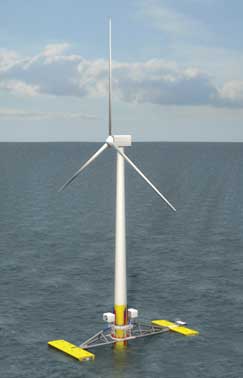
The Wave Treader is mounted on the base of a static offshore structure, such as a wind turbine
With 70 per cent of the earth’s surface covered by water mankind has long taken sustenance from it. Now engineers are developing new ways to harness its power and transform it into electricity.
UK-based Green Ocean Energy is developing two devices that will harness the waters of the north Atlantic: the Ocean Treader and Wave Treader.
Both are designed to bob on the surface of the ocean while waves cause attached floating arms to move up and down, powering on-board generators, which then send electricity back to shore via underwater cables.
The Ocean Treader is much like a buoy with a pair of arms, and is meant to be moored one to two miles offshore in open water. The Wave Treader shares a similar design but is mounted on the base of a static offshore structure, such as a wind turbine or tidal turbine.
Autodesk Inventor was used to design the mechanical parts for both variations, giving the designers the necessary model to begin the arduous testing needed to give the Treaders their expected 25-year life. This is a tough target to achieve considering that the machines must withstand the rough waters and gale-force winds of the Atlantic Ocean.
Each machine is designed to produce 500 kilowatts of electricity, enough to power 125 homes, with the idea for ‘farms’ of the Treaders being placed in the water – 30 such devices would generate 15 megawatts of power.
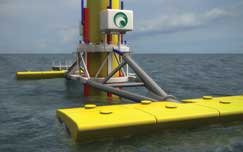
The arms on Green Ocean Energy’s Treaders bob up and down with the waves to produce electricity
“Because prototypes cost over $3 million dollars each and take months to construct, numerous rounds of hardware test-and-redesign cycles are impractical,” says George Smith, MD of Green Ocean Energy.
Instead, the company utilises the hydrodynamic and structural analysis tools from Ansys in the design process to help reach the balance between structural strength and optimal weight.
“The virtual prototyping capabilities of the Ansys tools have been a critical element in getting the products to produce maximum energy output as well as to operate effectively for decades,” adds George.
The digital prototypes have allowed the firm to begin extensive indoor wave-pool testing, before raising funds to develop a full-size prototype to start offshore testing in 2011.
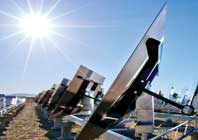
How engineers are using the Earth’s renewable resources to harness green energy






